Analyzing Emerging Trends in Leadership: A Report on Covey’s 7 Habits
VerifiedAdded on 2023/06/03
|5
|1528
|485
Report
AI Summary
This report explores emerging trends in leadership, focusing on Dr. Stephen Covey's 'The 7 Habits of Highly Effective People.' It emphasizes a shift from time management to a behavioral framework, highlighting the importance of changing one's perception and focusing on core personality traits for success. The report discusses transformational leadership, key leadership traits such as proactivity and prioritizing win-win situations, and the significance of understanding others and maintaining life balance. It also addresses shortcomings of transformational leadership, including oversight of details and employee favoritism, suggesting the need for self-awareness and equal treatment. The document is available on Desklib, a platform that provides students with access to past papers and solved assignments.
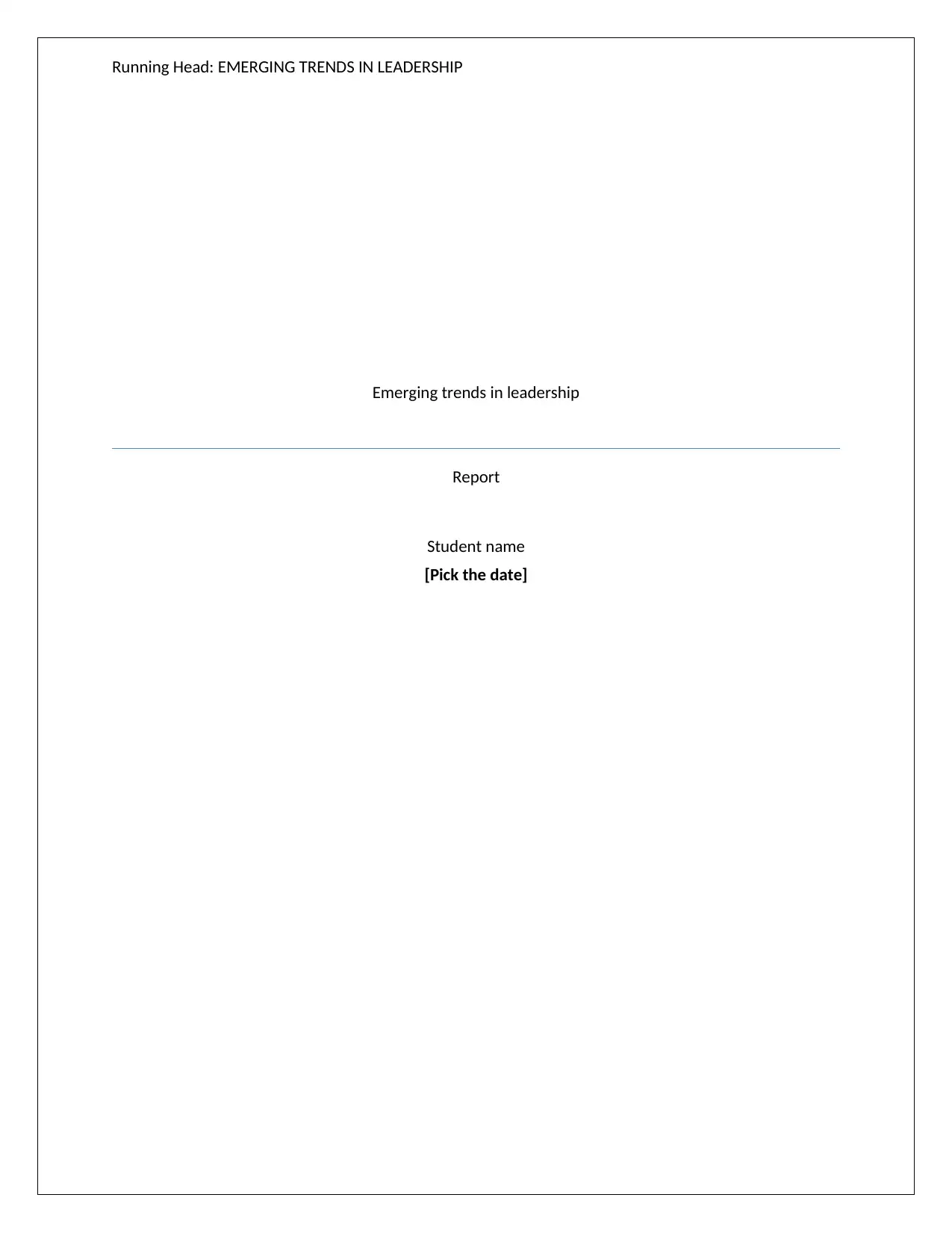
Running Head: EMERGING TRENDS IN LEADERSHIP
Emerging trends in leadership
Report
Student name
[Pick the date]
Emerging trends in leadership
Report
Student name
[Pick the date]
Paraphrase This Document
Need a fresh take? Get an instant paraphrase of this document with our AI Paraphraser
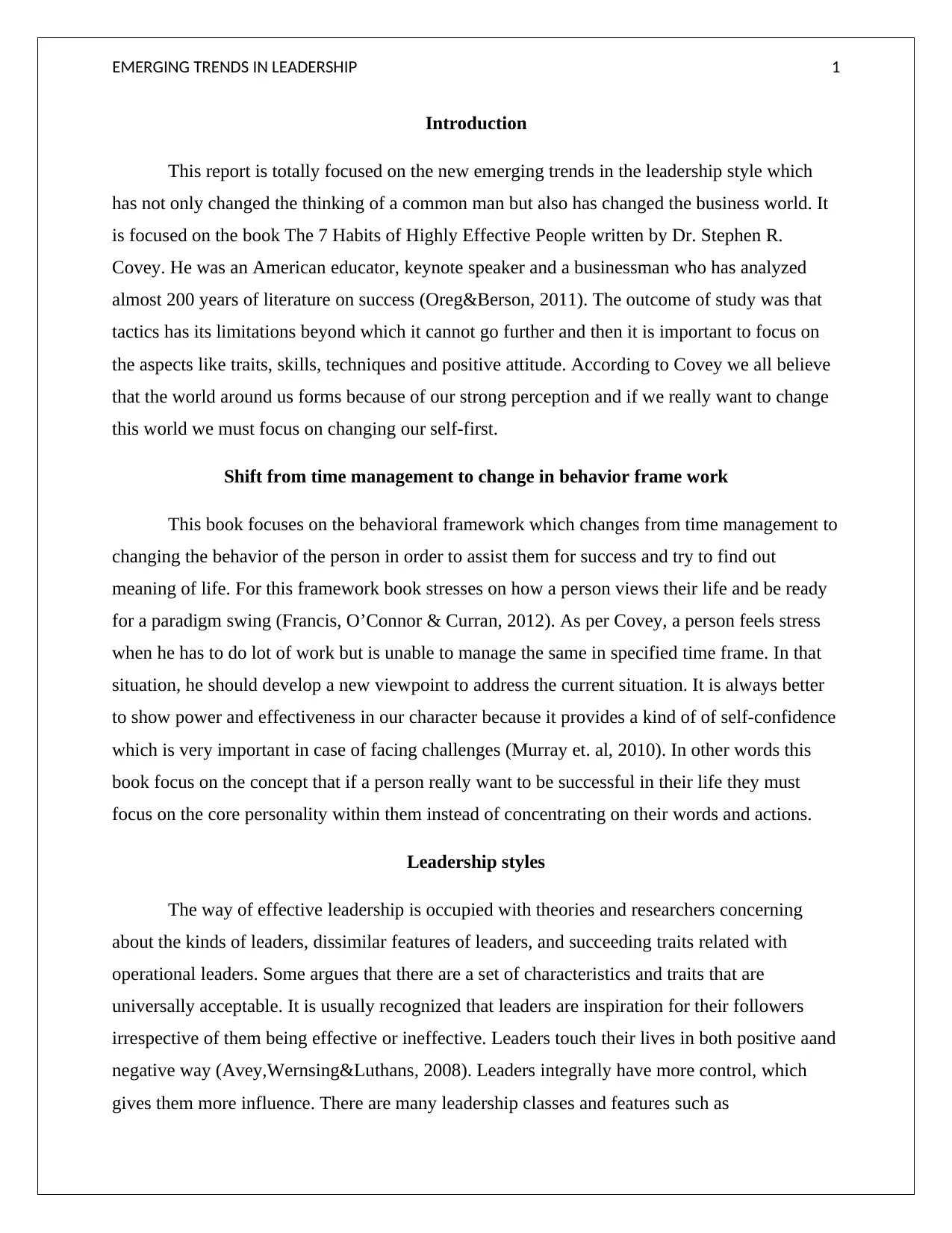
EMERGING TRENDS IN LEADERSHIP 1
Introduction
This report is totally focused on the new emerging trends in the leadership style which
has not only changed the thinking of a common man but also has changed the business world. It
is focused on the book The 7 Habits of Highly Effective People written by Dr. Stephen R.
Covey. He was an American educator, keynote speaker and a businessman who has analyzed
almost 200 years of literature on success (Oreg&Berson, 2011). The outcome of study was that
tactics has its limitations beyond which it cannot go further and then it is important to focus on
the aspects like traits, skills, techniques and positive attitude. According to Covey we all believe
that the world around us forms because of our strong perception and if we really want to change
this world we must focus on changing our self-first.
Shift from time management to change in behavior frame work
This book focuses on the behavioral framework which changes from time management to
changing the behavior of the person in order to assist them for success and try to find out
meaning of life. For this framework book stresses on how a person views their life and be ready
for a paradigm swing (Francis, O’Connor & Curran, 2012). As per Covey, a person feels stress
when he has to do lot of work but is unable to manage the same in specified time frame. In that
situation, he should develop a new viewpoint to address the current situation. It is always better
to show power and effectiveness in our character because it provides a kind of of self-confidence
which is very important in case of facing challenges (Murray et. al, 2010). In other words this
book focus on the concept that if a person really want to be successful in their life they must
focus on the core personality within them instead of concentrating on their words and actions.
Leadership styles
The way of effective leadership is occupied with theories and researchers concerning
about the kinds of leaders, dissimilar features of leaders, and succeeding traits related with
operational leaders. Some argues that there are a set of characteristics and traits that are
universally acceptable. It is usually recognized that leaders are inspiration for their followers
irrespective of them being effective or ineffective. Leaders touch their lives in both positive aand
negative way (Avey,Wernsing&Luthans, 2008). Leaders integrally have more control, which
gives them more influence. There are many leadership classes and features such as
Introduction
This report is totally focused on the new emerging trends in the leadership style which
has not only changed the thinking of a common man but also has changed the business world. It
is focused on the book The 7 Habits of Highly Effective People written by Dr. Stephen R.
Covey. He was an American educator, keynote speaker and a businessman who has analyzed
almost 200 years of literature on success (Oreg&Berson, 2011). The outcome of study was that
tactics has its limitations beyond which it cannot go further and then it is important to focus on
the aspects like traits, skills, techniques and positive attitude. According to Covey we all believe
that the world around us forms because of our strong perception and if we really want to change
this world we must focus on changing our self-first.
Shift from time management to change in behavior frame work
This book focuses on the behavioral framework which changes from time management to
changing the behavior of the person in order to assist them for success and try to find out
meaning of life. For this framework book stresses on how a person views their life and be ready
for a paradigm swing (Francis, O’Connor & Curran, 2012). As per Covey, a person feels stress
when he has to do lot of work but is unable to manage the same in specified time frame. In that
situation, he should develop a new viewpoint to address the current situation. It is always better
to show power and effectiveness in our character because it provides a kind of of self-confidence
which is very important in case of facing challenges (Murray et. al, 2010). In other words this
book focus on the concept that if a person really want to be successful in their life they must
focus on the core personality within them instead of concentrating on their words and actions.
Leadership styles
The way of effective leadership is occupied with theories and researchers concerning
about the kinds of leaders, dissimilar features of leaders, and succeeding traits related with
operational leaders. Some argues that there are a set of characteristics and traits that are
universally acceptable. It is usually recognized that leaders are inspiration for their followers
irrespective of them being effective or ineffective. Leaders touch their lives in both positive aand
negative way (Avey,Wernsing&Luthans, 2008). Leaders integrally have more control, which
gives them more influence. There are many leadership classes and features such as
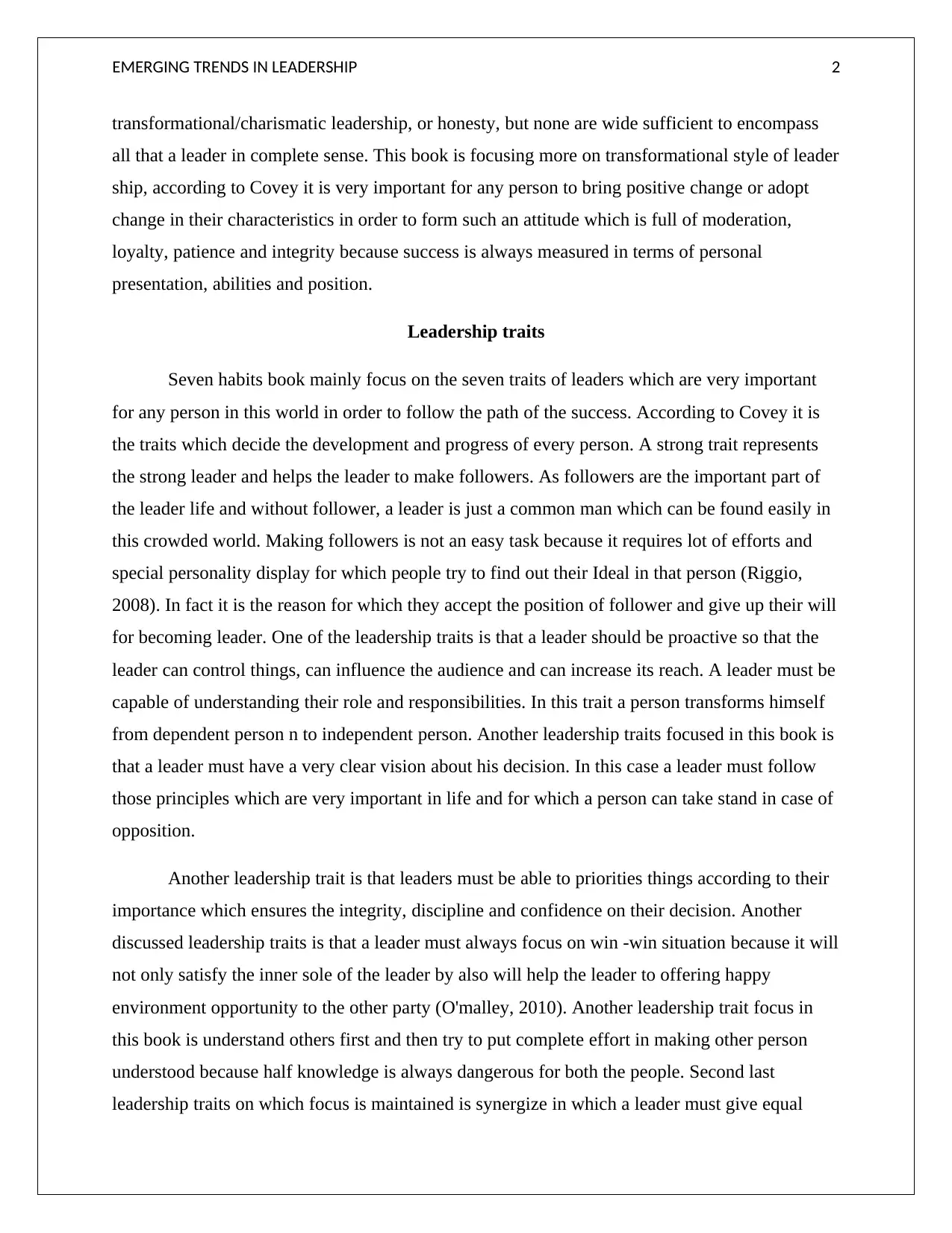
EMERGING TRENDS IN LEADERSHIP 2
transformational/charismatic leadership, or honesty, but none are wide sufficient to encompass
all that a leader in complete sense. This book is focusing more on transformational style of leader
ship, according to Covey it is very important for any person to bring positive change or adopt
change in their characteristics in order to form such an attitude which is full of moderation,
loyalty, patience and integrity because success is always measured in terms of personal
presentation, abilities and position.
Leadership traits
Seven habits book mainly focus on the seven traits of leaders which are very important
for any person in this world in order to follow the path of the success. According to Covey it is
the traits which decide the development and progress of every person. A strong trait represents
the strong leader and helps the leader to make followers. As followers are the important part of
the leader life and without follower, a leader is just a common man which can be found easily in
this crowded world. Making followers is not an easy task because it requires lot of efforts and
special personality display for which people try to find out their Ideal in that person (Riggio,
2008). In fact it is the reason for which they accept the position of follower and give up their will
for becoming leader. One of the leadership traits is that a leader should be proactive so that the
leader can control things, can influence the audience and can increase its reach. A leader must be
capable of understanding their role and responsibilities. In this trait a person transforms himself
from dependent person n to independent person. Another leadership traits focused in this book is
that a leader must have a very clear vision about his decision. In this case a leader must follow
those principles which are very important in life and for which a person can take stand in case of
opposition.
Another leadership trait is that leaders must be able to priorities things according to their
importance which ensures the integrity, discipline and confidence on their decision. Another
discussed leadership traits is that a leader must always focus on win -win situation because it will
not only satisfy the inner sole of the leader by also will help the leader to offering happy
environment opportunity to the other party (O'malley, 2010). Another leadership trait focus in
this book is understand others first and then try to put complete effort in making other person
understood because half knowledge is always dangerous for both the people. Second last
leadership traits on which focus is maintained is synergize in which a leader must give equal
transformational/charismatic leadership, or honesty, but none are wide sufficient to encompass
all that a leader in complete sense. This book is focusing more on transformational style of leader
ship, according to Covey it is very important for any person to bring positive change or adopt
change in their characteristics in order to form such an attitude which is full of moderation,
loyalty, patience and integrity because success is always measured in terms of personal
presentation, abilities and position.
Leadership traits
Seven habits book mainly focus on the seven traits of leaders which are very important
for any person in this world in order to follow the path of the success. According to Covey it is
the traits which decide the development and progress of every person. A strong trait represents
the strong leader and helps the leader to make followers. As followers are the important part of
the leader life and without follower, a leader is just a common man which can be found easily in
this crowded world. Making followers is not an easy task because it requires lot of efforts and
special personality display for which people try to find out their Ideal in that person (Riggio,
2008). In fact it is the reason for which they accept the position of follower and give up their will
for becoming leader. One of the leadership traits is that a leader should be proactive so that the
leader can control things, can influence the audience and can increase its reach. A leader must be
capable of understanding their role and responsibilities. In this trait a person transforms himself
from dependent person n to independent person. Another leadership traits focused in this book is
that a leader must have a very clear vision about his decision. In this case a leader must follow
those principles which are very important in life and for which a person can take stand in case of
opposition.
Another leadership trait is that leaders must be able to priorities things according to their
importance which ensures the integrity, discipline and confidence on their decision. Another
discussed leadership traits is that a leader must always focus on win -win situation because it will
not only satisfy the inner sole of the leader by also will help the leader to offering happy
environment opportunity to the other party (O'malley, 2010). Another leadership trait focus in
this book is understand others first and then try to put complete effort in making other person
understood because half knowledge is always dangerous for both the people. Second last
leadership traits on which focus is maintained is synergize in which a leader must give equal
⊘ This is a preview!⊘
Do you want full access?
Subscribe today to unlock all pages.

Trusted by 1+ million students worldwide
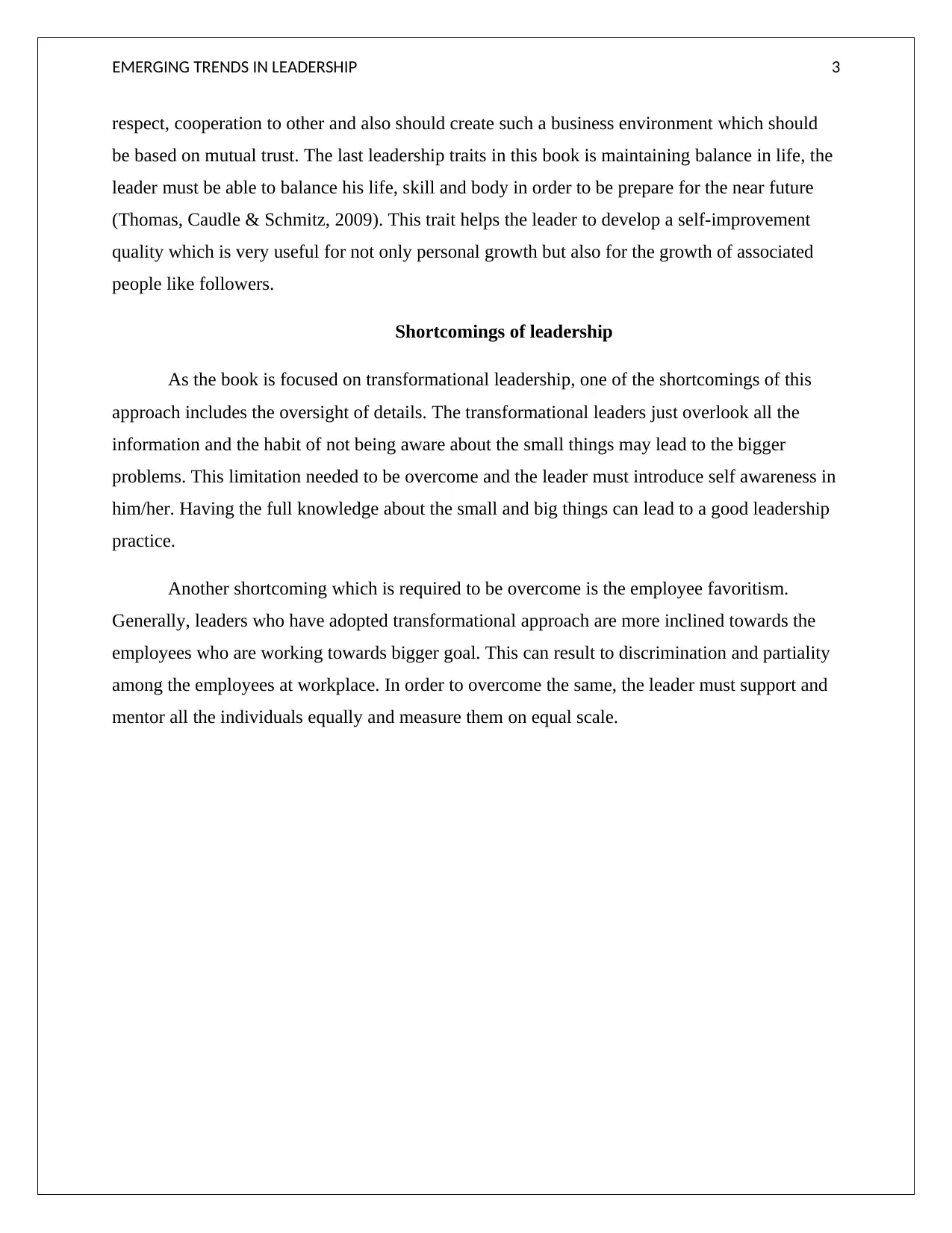
EMERGING TRENDS IN LEADERSHIP 3
respect, cooperation to other and also should create such a business environment which should
be based on mutual trust. The last leadership traits in this book is maintaining balance in life, the
leader must be able to balance his life, skill and body in order to be prepare for the near future
(Thomas, Caudle & Schmitz, 2009). This trait helps the leader to develop a self-improvement
quality which is very useful for not only personal growth but also for the growth of associated
people like followers.
Shortcomings of leadership
As the book is focused on transformational leadership, one of the shortcomings of this
approach includes the oversight of details. The transformational leaders just overlook all the
information and the habit of not being aware about the small things may lead to the bigger
problems. This limitation needed to be overcome and the leader must introduce self awareness in
him/her. Having the full knowledge about the small and big things can lead to a good leadership
practice.
Another shortcoming which is required to be overcome is the employee favoritism.
Generally, leaders who have adopted transformational approach are more inclined towards the
employees who are working towards bigger goal. This can result to discrimination and partiality
among the employees at workplace. In order to overcome the same, the leader must support and
mentor all the individuals equally and measure them on equal scale.
respect, cooperation to other and also should create such a business environment which should
be based on mutual trust. The last leadership traits in this book is maintaining balance in life, the
leader must be able to balance his life, skill and body in order to be prepare for the near future
(Thomas, Caudle & Schmitz, 2009). This trait helps the leader to develop a self-improvement
quality which is very useful for not only personal growth but also for the growth of associated
people like followers.
Shortcomings of leadership
As the book is focused on transformational leadership, one of the shortcomings of this
approach includes the oversight of details. The transformational leaders just overlook all the
information and the habit of not being aware about the small things may lead to the bigger
problems. This limitation needed to be overcome and the leader must introduce self awareness in
him/her. Having the full knowledge about the small and big things can lead to a good leadership
practice.
Another shortcoming which is required to be overcome is the employee favoritism.
Generally, leaders who have adopted transformational approach are more inclined towards the
employees who are working towards bigger goal. This can result to discrimination and partiality
among the employees at workplace. In order to overcome the same, the leader must support and
mentor all the individuals equally and measure them on equal scale.
Paraphrase This Document
Need a fresh take? Get an instant paraphrase of this document with our AI Paraphraser
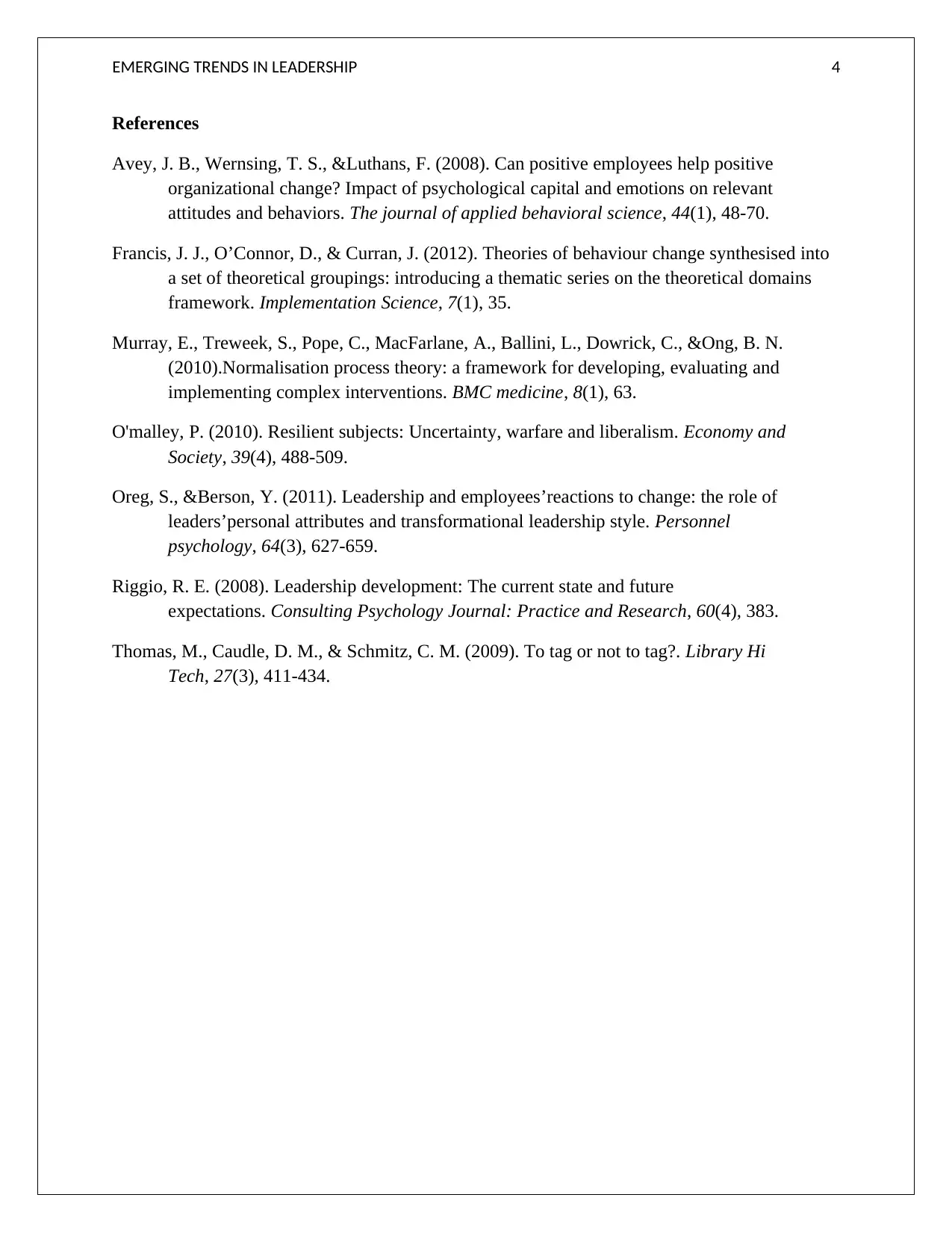
EMERGING TRENDS IN LEADERSHIP 4
References
Avey, J. B., Wernsing, T. S., &Luthans, F. (2008). Can positive employees help positive
organizational change? Impact of psychological capital and emotions on relevant
attitudes and behaviors. The journal of applied behavioral science, 44(1), 48-70.
Francis, J. J., O’Connor, D., & Curran, J. (2012). Theories of behaviour change synthesised into
a set of theoretical groupings: introducing a thematic series on the theoretical domains
framework. Implementation Science, 7(1), 35.
Murray, E., Treweek, S., Pope, C., MacFarlane, A., Ballini, L., Dowrick, C., &Ong, B. N.
(2010).Normalisation process theory: a framework for developing, evaluating and
implementing complex interventions. BMC medicine, 8(1), 63.
O'malley, P. (2010). Resilient subjects: Uncertainty, warfare and liberalism. Economy and
Society, 39(4), 488-509.
Oreg, S., &Berson, Y. (2011). Leadership and employees’reactions to change: the role of
leaders’personal attributes and transformational leadership style. Personnel
psychology, 64(3), 627-659.
Riggio, R. E. (2008). Leadership development: The current state and future
expectations. Consulting Psychology Journal: Practice and Research, 60(4), 383.
Thomas, M., Caudle, D. M., & Schmitz, C. M. (2009). To tag or not to tag?. Library Hi
Tech, 27(3), 411-434.
References
Avey, J. B., Wernsing, T. S., &Luthans, F. (2008). Can positive employees help positive
organizational change? Impact of psychological capital and emotions on relevant
attitudes and behaviors. The journal of applied behavioral science, 44(1), 48-70.
Francis, J. J., O’Connor, D., & Curran, J. (2012). Theories of behaviour change synthesised into
a set of theoretical groupings: introducing a thematic series on the theoretical domains
framework. Implementation Science, 7(1), 35.
Murray, E., Treweek, S., Pope, C., MacFarlane, A., Ballini, L., Dowrick, C., &Ong, B. N.
(2010).Normalisation process theory: a framework for developing, evaluating and
implementing complex interventions. BMC medicine, 8(1), 63.
O'malley, P. (2010). Resilient subjects: Uncertainty, warfare and liberalism. Economy and
Society, 39(4), 488-509.
Oreg, S., &Berson, Y. (2011). Leadership and employees’reactions to change: the role of
leaders’personal attributes and transformational leadership style. Personnel
psychology, 64(3), 627-659.
Riggio, R. E. (2008). Leadership development: The current state and future
expectations. Consulting Psychology Journal: Practice and Research, 60(4), 383.
Thomas, M., Caudle, D. M., & Schmitz, C. M. (2009). To tag or not to tag?. Library Hi
Tech, 27(3), 411-434.
1 out of 5
Related Documents
Your All-in-One AI-Powered Toolkit for Academic Success.
+13062052269
info@desklib.com
Available 24*7 on WhatsApp / Email
![[object Object]](/_next/static/media/star-bottom.7253800d.svg)
Unlock your academic potential
Copyright © 2020–2025 A2Z Services. All Rights Reserved. Developed and managed by ZUCOL.





